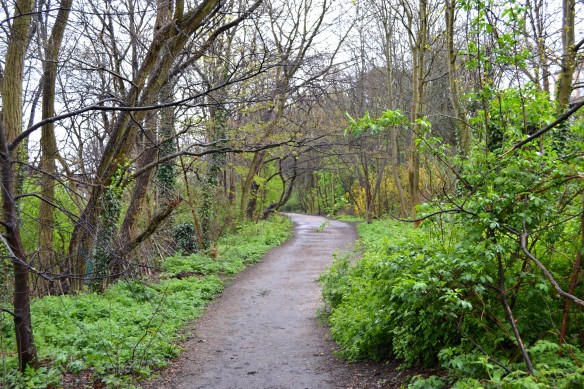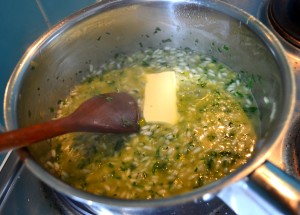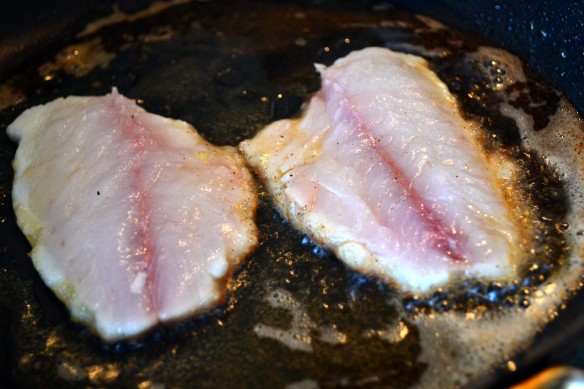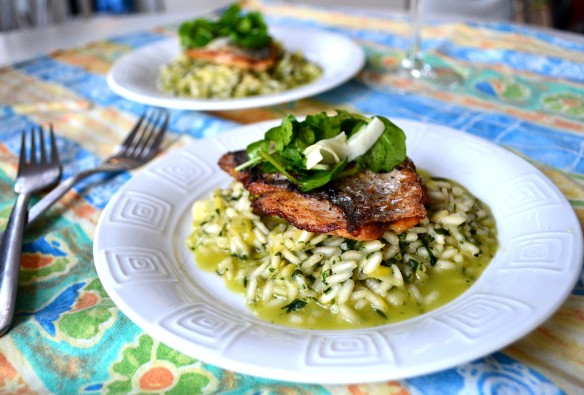 Last week a new friend of mine, Nicola (a brilliant cook and blogger in her own right), crowed on Twitter about a recent discovery: she’d found loads of wild garlic at a Secret Location. I immediately demanded to be taken to the spot. She agreed, but not before exacting a “wild garlic tax” (some of my orange-blossom-saffron-vanilla macarons). It was an easy trade. I adore wild garlic. Wild garlic, also known as ramps, wild leek, and wood leek, grows in cool damp woody areas. Its colour is strikingly chlorophyll green and it’s got a sharp allium flavour and intense aroma. It’s gorgeous stuff. Monday, the appointed day, was cool and very wet. Nicola picked me up from an Overground station, her sweet and excitable dog, Toro, in the back of the car, and drove us to the Secret Location, a lovely wooded path Somewhere In London.
Last week a new friend of mine, Nicola (a brilliant cook and blogger in her own right), crowed on Twitter about a recent discovery: she’d found loads of wild garlic at a Secret Location. I immediately demanded to be taken to the spot. She agreed, but not before exacting a “wild garlic tax” (some of my orange-blossom-saffron-vanilla macarons). It was an easy trade. I adore wild garlic. Wild garlic, also known as ramps, wild leek, and wood leek, grows in cool damp woody areas. Its colour is strikingly chlorophyll green and it’s got a sharp allium flavour and intense aroma. It’s gorgeous stuff. Monday, the appointed day, was cool and very wet. Nicola picked me up from an Overground station, her sweet and excitable dog, Toro, in the back of the car, and drove us to the Secret Location, a lovely wooded path Somewhere In London.  Spread out over about half a mile of light woodland there were three flourishing patches of wild garlic. A wild garlic plant has maybe three or four leaves. More mature plants will have started to grow stiff green shoots and buds. We plucked the leaves and buds, doing our best to leave the delicate roots intact. It was slippery, muddy, satisfying work. Even though Toro did his best to distract us, in no time we’d gathered an astonishing quantity of wild garlic.
Spread out over about half a mile of light woodland there were three flourishing patches of wild garlic. A wild garlic plant has maybe three or four leaves. More mature plants will have started to grow stiff green shoots and buds. We plucked the leaves and buds, doing our best to leave the delicate roots intact. It was slippery, muddy, satisfying work. Even though Toro did his best to distract us, in no time we’d gathered an astonishing quantity of wild garlic.  Back at Nicola’s, we made a wild garlic and hazelnut pesto which Nicola served with spaghetti (and a magnificent steak), and yesterday at home I minced some, froze some, and used the rest to make a wild garlic and leek risotto, which I served with crispy skin bream and a fennel and watercress salad.
Back at Nicola’s, we made a wild garlic and hazelnut pesto which Nicola served with spaghetti (and a magnificent steak), and yesterday at home I minced some, froze some, and used the rest to make a wild garlic and leek risotto, which I served with crispy skin bream and a fennel and watercress salad.
I really loved this dish. The risotto is staggeringly good – buttery, rich, sweet, sharp, and delicate at the same time. If you’re a vegetarian, or if you’d simply like to enjoy the unadulterated flavour of the wild garlic, it is delicious served on its own or topped with a few curls of aged parmesan. The risotto complements the delicate fish beautifully, however. The fish has a nutty, buttery taste from being crisped in brown butter, and the lemony salad adds brightness and acidity. And it’s quick and easy to prepare: I reckon it took me less than 45 minutes.
Wild Garlic and Leek Risotto with Crispy-Skin Bream, Shaved Fennel, and Watercress
For the Risotto
450 grams (about 2 cups) Carnaroli or Arborio rice (I prefer Carnaroli rice over Arborio rice for risotto, but of course you should suit your own preferences)
100 grams (approximately 3.5 ounces) butter
1200 ml (approximately 1.25 quarts) vegetable stock or white chicken stock
230 ml (about 1 cup) white wine
2 leeks, green part trimmed for another use, white part finely diced
4-5 tablespoons of wild garlic leaves and shoots, washed and pulverized in a food processor or finely minced
Salt and freshly ground black pepper to taste
For the Fish
500-750 grams (or between a pound a pound and a half) bream fillets, skin on, or one fillet per person (you can substitute any firm white fish)
75 grams butter
50 grams olive oil
For the Salad
One bulb fennel, trimmed, cored, and finely shaved with a microplane or a very sharp knife
1/2 cup watercress, picked through and tough stems discarded
1 teaspoon finely grated lemon zest
Juice of one half lemon
1 tablespoon extra virgin olive oil
A generous pinch of coarse salt
If you are serving this dish with the fish, after you have completed your prep for the risotto combine the fennel, watercress, lemon juice, lemon zest and olive oil and coarse salt in a bowl and set aside.
To prepare the risotto, start by bringing your stock to a low simmer on your stovetop. You will want to keep the stock hot while you’re cooking the risotto. Next, melt most of the butter for the risotto (leaving aside a knob to add at the end) in a heavy bottomed pot. Sauté the leeks in the butter over medium-high heat until they are semi-transparent, and then add all the wine.
 When about half your wine has steamed off, stir in your risotto rice and toss gently with a wooden spoon over medium high heat until most of the liquid has evaporated. Reduce the heat to medium, and start adding the hot stock by the ladleful. You want to stir occasionally: enough to keep the risotto on the bottom of the pan from burning, but not so much that you break away the starch from the rice grains and make a gluey mess. Use a folding, scraping motion rather than a vigorous stirring motion. Add another ladle of stock as each ladleful cooks into the rice. This process should take about 20-25 minutes.
When about half your wine has steamed off, stir in your risotto rice and toss gently with a wooden spoon over medium high heat until most of the liquid has evaporated. Reduce the heat to medium, and start adding the hot stock by the ladleful. You want to stir occasionally: enough to keep the risotto on the bottom of the pan from burning, but not so much that you break away the starch from the rice grains and make a gluey mess. Use a folding, scraping motion rather than a vigorous stirring motion. Add another ladle of stock as each ladleful cooks into the rice. This process should take about 20-25 minutes.
When you’ve added most of your stock, add the wild garlic and stir through, and season with salt and pepper. (One and a half to two teaspoons of salt should be about right.) You can start testing the risotto: you want the rice to be firm and just slightly al dente, with a soft, creamy liquid around it. A good risotto should spread on the plate; it should not be stiff or pasty.
 After your risotto is cooked to your liking, stir in the last dollop of butter to give it a little extra gloss and set aside.
After your risotto is cooked to your liking, stir in the last dollop of butter to give it a little extra gloss and set aside.
 For the fish, heat the remaining butter and olive oil in a heavy bottomed skillet over medium-high heat until the butter has foamed and started to turn golden and the pan feels hot if you hold your hand above it. Fry the fish skin side down, pressing each fillet firmly with a spatula to keep it from curling and to get all the skin to crisp up. When the edges of the fish have turned golden flip the fillets once.
For the fish, heat the remaining butter and olive oil in a heavy bottomed skillet over medium-high heat until the butter has foamed and started to turn golden and the pan feels hot if you hold your hand above it. Fry the fish skin side down, pressing each fillet firmly with a spatula to keep it from curling and to get all the skin to crisp up. When the edges of the fish have turned golden flip the fillets once.
 To serve, ladle some risotto into the center of warmed plates, lie a fillet on top skin side up, and top with a bit of the shaved fennel and watercress. Bon appétit!
To serve, ladle some risotto into the center of warmed plates, lie a fillet on top skin side up, and top with a bit of the shaved fennel and watercress. Bon appétit!




Foraging can be so much fun. Wish I could find hazelnuts to forage for though.
My parents had a hazelnut bush on their property in upstate NY. What I remember most about picking hazelnuts is that earwigs loved them — I have very vivid memories of pulling apart the green sticky leaves around the nuts and finding them! So I’m not in a hurry to forage for them. 😉
The lane and dog photos are grand!
Thank you Michelle! The dog was hilarious; he kept galloping through our wild garlic patches.
Yummy! This looks absolutely amazing. What a hoard! I would totally keep that hush hush! You have a very, very cool friend who is willing to share her forager’s secret spaces.
I know! I don’t know what I did to deserve this — clearly this is a debt I can never repay!
I’m so envious! I’d love to go foraging too but I don’t recognise any plants and wouldn’t know what to look for!
Wild garlic is pretty distinctive: if you see the pointy green leaves and they smell strongly oniony-garlicky, you’ve found it! It’s worth a go; apparently it grows in profusion here. Good luck!
You’re so lucky to get a tip-off! I just bought a bunch from the farmer’s market, jealous you got them for free! i’ve always wanted to try foraging, almost signed up for a mushroom foraging tour but it was fully booked then, and then I just got discouraged. trying to see if i can recognise the location from the pictures but alas, all woods look the same to me ):
I recognize a fair number of wild mushrooms. Maybe We Should Go Foraging!
I love the idea of foraging for something to make a meal from. We recently found some morel mushrooms and had a feast! Your meal looks so healthy and delicious – a hard combination at times.
Do you know I only just saw this comment now? WordPress has been a bit erratic. I LOVE morels. I’m jealous!
Beautiful- will definitely try making
Wonderful! Let me know what you think if you do!
Pingback: 12 Recipes to Celebrate Spring Veggies | Life'd